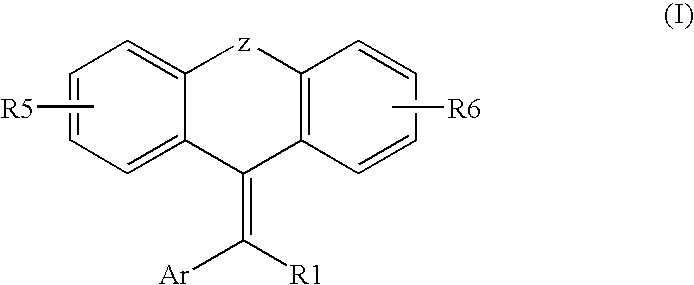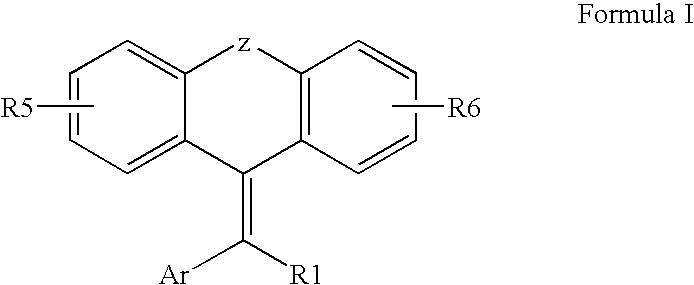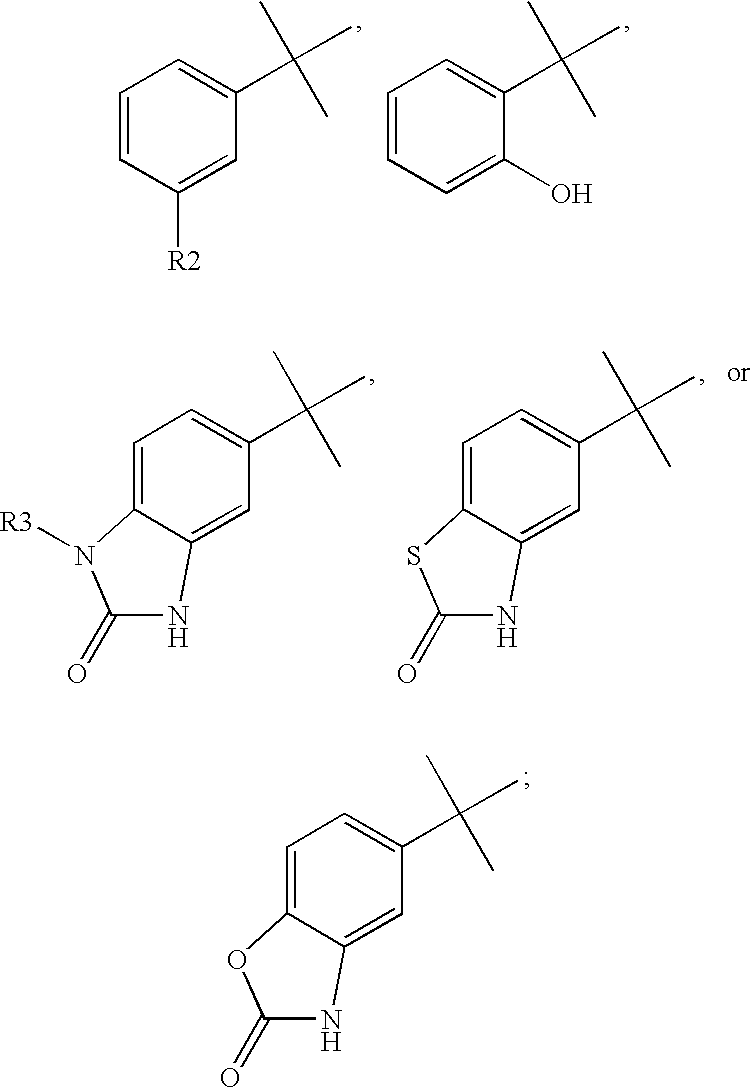Tricyclic steroid hormone nuclear receptor modulators
- Summary
- Abstract
- Description
- Claims
- Application Information
AI Technical Summary
Benefits of technology
Problems solved by technology
Method used
Image
Examples
preparation 1
9-Hydroxy-9-methylthioxanthine
[0197]
[0198] Prepare solution by dissolving 2.12 g (10 mmol) of thioxanthone in 50 mL of anhydrous THF. Add a solution of 5 mL of 3M methylmagnesium bromide in THF (15 mmol) and stir the reaction at ambient temperature. Allow the reaction to proceed for sixteen hours. Quench the reaction with the addition of 1N HCl and add 50 mL of EtOAc. Separate the organic layer and dry by filtration through anhydrous Na2SO4. Remove the volatiles by evaporation in vacuo. Isolate this product (1.77 g) as a brown oil and use in subsequent reactions without further purification.
preparation 2
9-Methylenethioxanthine
[0199]
[0200] Dissolve all of the product from Preparation 1 in 25 mL of glacial acetic acid and add 1 mL of concentrated sulfuric acid. Attach a drying tube to the reaction vessel. Stir the reaction and allow to proceed for sixteen hours at ambient temperature. Reduce the reaction volume by evaporation, and quench the reaction with the addition of water. Extract the reaction mixture with EtOAc and separate the organic layer. Wash the EtOAc extract with a saturated aqueous solution of sodium carbonate, follow with an extraction with water, and finally dry with anhydrous Na2SO4 and evaporate to an oil. Purify the resulting crude product by chromatography on silica gel eluted with Hexane-EtOAc(4:1 v / v). Collect the appropriate fractions and evaporate to dryness. This procedure yields 370 mg of the title compound as a tan amorphous powder, with the following physical chemical characteristics:
[0201]1H NMR (CDCl3)δ 5.55 (s, 2H), 7.24-7.37 (m, 6H), 7.62 (m,2H).
[02...
preparation 3
9-Ethylene-thioxanthine
[0205]
[0206] Prepare a suspension of 14.7 g (70 mmol) thioxanthone in 150 mL of THF. Add fifty mL of 3M ethylmagnesium bromide in ether. Heat the reaction mixture to reflux for sixteen hours. Quench the reaction by the addition of 25 mL of 5N HCl and 100 mL of water. Separate and wash the THF layer with a solution of saturated aqueous sodium bicarbonate. Dry the organic layer with anhydrous Na2SO4 and evaporate down to a brown oil. Re-dissolve the oil in 100 mL of THF and add 10 mL of concentrated sulfuric acid. Stir the reaction and allow to proceed for several hours. Wash the mixture with water, and neutralize with saturated sodium bicarbonate solution. Dry the organic solution with Na2SO4 and evaporate to an oil. Chromatograph the crude product on silica gel eluting with a solvent of EtOAc-hexane (1:3 v / v). This procedure yields 3 g of the title compound as a tan amorphous powder with following characteristics.
[0207]1H NMR (CDCl3) δ 2.02 (d, 3H), 6.05 (q,...
PUM
 Login to View More
Login to View More Abstract
Description
Claims
Application Information
 Login to View More
Login to View More - R&D
- Intellectual Property
- Life Sciences
- Materials
- Tech Scout
- Unparalleled Data Quality
- Higher Quality Content
- 60% Fewer Hallucinations
Browse by: Latest US Patents, China's latest patents, Technical Efficacy Thesaurus, Application Domain, Technology Topic, Popular Technical Reports.
© 2025 PatSnap. All rights reserved.Legal|Privacy policy|Modern Slavery Act Transparency Statement|Sitemap|About US| Contact US: help@patsnap.com



